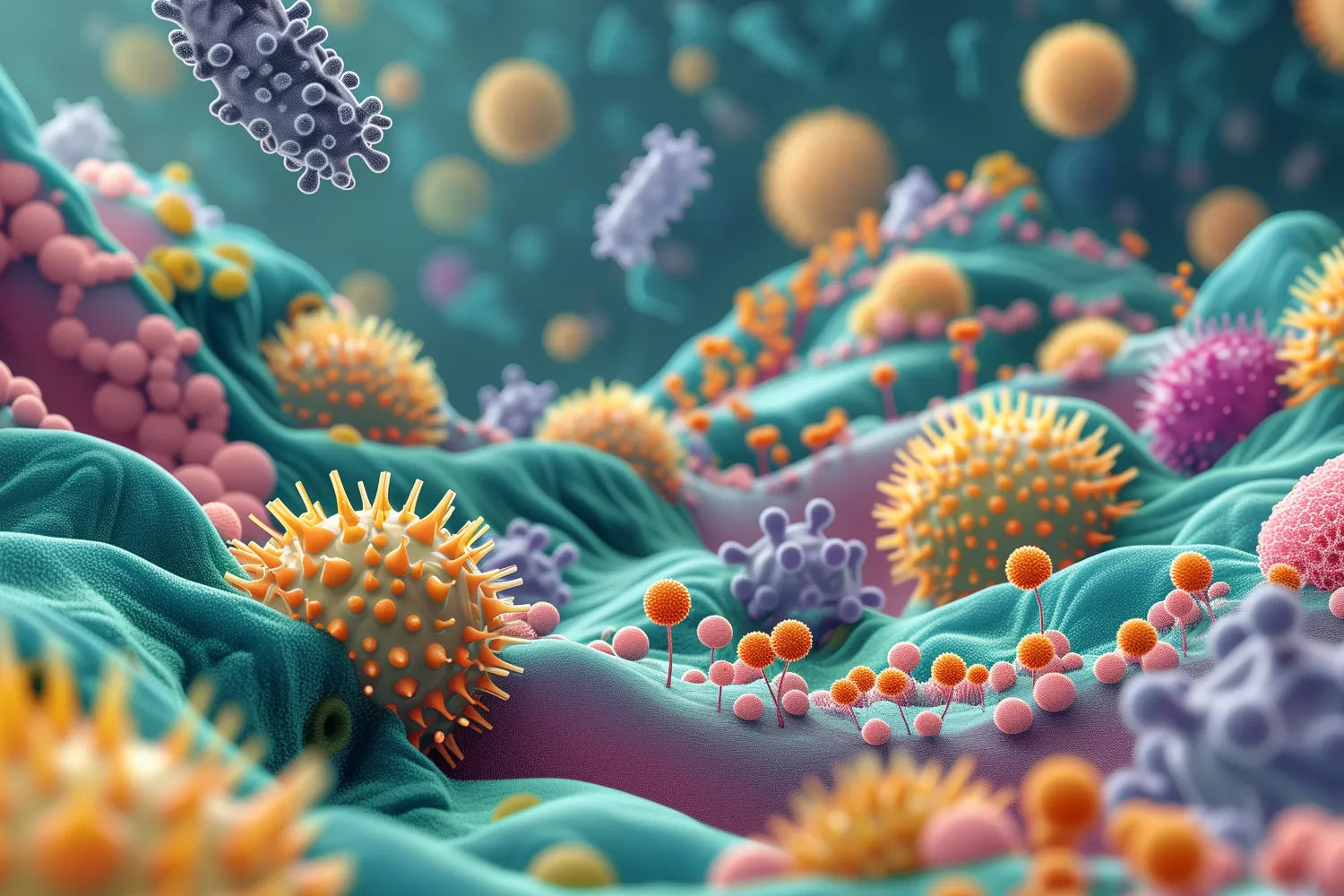
Dr. Eric Venn-Watson’s Highlights
-
Amino acids are the building blocks of the body.
Taking amino acid supplements has become a popular trend to support certain aspects of your health.
Taking a fatty acid supplement, like fatty15, can give your body a daily dose of an essential nutrient that supports your health on a cellular level.*
Your gym buddies and coworkers are all taking an amino acid supplement, and you’re admittedly feeling a little lost. Don’t worry; we’ll help you understand what amino acids are and why they are important.
We’ll also help you understand why taking a fatty acid supplement might be a better option for supporting your total health and wellness.
What Are Amino Acids?
Amino acids are molecules that form the building blocks of protein. You need amino acids to create protein in your body, which builds other tissues (muscles and beyond!). Collagen, for example, is an abundant tissue in the body that is a protein created from amino acids.
You are left with amino acids when proteins are broken down in the foods you eat (proteins are a macronutrient). Amino acids also help give the body energy, especially during sustained periods of athletic activity.
While most of the energy your body needs to move your muscles comes from stored glycogen within the muscles, additional energy comes from glucose in the blood and amino acids (particularly leucine) that can be oxidized into fuel during lengthy workouts. Another amino acid, alanine, helps maintain blood glucose homeostasis while you burn calories through exercise.
Chemical Structure of Amino Acids
Amino acids consists of a carbon atom, a hydrogen atom, a carboxyl group, and an amino group. These little molecules link and form a side chain linked together by bonds.
Three Types of Amino Acids
Amino acids are categorized into different groups depending on how the body uses them and whether or not the body can make them independently.
Essential Amino Acids
Essential amino acids are ones your body must have but cannot make on its own. There are nine essential amino acids: histidine, isoleucine, leucine, lysine, methionine, phenylalanine, threonine, tryptophan, and valine.
Foods containing all nine essential amino acids are called complete proteins. They include beef, chicken, poultry, fish, eggs, soy, buckwheat, dairy, and quinoa.
Nonessential Amino Acids
Our bodies can make these amino acids even if we don’t get them from our food sources. The 11 nonessential amino acids include alanine, arginine, asparagine, aspartic acid, cysteine, glutamic acid, glutamine, glycine, proline, serine, and tyrosine.
You’ve probably seen supplements that contain beta-alanine and L-glutamine. These are usually targeted toward people who want faster muscle recovery and muscle building.
Conditional Amino Acids
Some nonessential amino acids are classified as conditional because our bodies only make them and need them when we are sick or under stress (like the kind your muscles undergo during weightlifting). These include arginine, cysteine, glutamine, tyrosine, glycine, ornithine, proline, and serine.
If you’re keeping score, you’ll notice there are 20 amino acids: nine, which are essential, and 11, which are nonessential.
What Do Amino Acids Do?
Amino acids are involved in numerous bodily processes and functions, but here are a few highlights:
- Histidine. This amino acid is crucial in forming neurotransmitters (messengers inside your brain) that help control functions like sleep and digestion.
- Glutamic acid. This acid makes glutamate (the most abundant neurotransmitter in your body). Too much glutamate in your system, however, is associated with Alzheimer’s and Parkinson’s Disease.
- Isoleucine. This amino acid helps your body make hemoglobin and stabilizes your body’s energy levels.
- Lysine. This amino acid helps the body absorb calcium.
- Phenylalanine. This amino acid helps produce chemicals in your brain, including norepinephrine, dopamine, and epinephrine.
- Tryptophan. The famous amino acid with heightened popularity around Thanksgiving, tryptophan, plays an important role in making serotonin.
In addition to these functions, your body uses amino acids to create nonessential fatty acids.
Amino Acids and Fatty Acids
Like amino acids, there are two types of fatty acids: essential and nonessential. When proteins are broken down in the blood, enzymes synthesize these extra amino acids into nonessential fatty acids, which are stored for later use.
Amino acids can’t help the human body create essential fatty acids. Those must come from food sources or supplementation.
Although you’re probably familiar with the omega essential fatty acids, there’s a new kid on the block that’s important for the health of your entire body.*
Its name is pentadecanoic acid, or C15:0 for short.
How Does C15:0 Compare to Omega-3?
C15:0 is an odd-chain, saturated fatty acid that the body can’t make on its own and needs to thrive. It’s the first fatty acid to have been discovered since the discovery of the omegas more than 90 years ago.
Moreover, science now supports that C15:0 is better, broader, and safer than the purest and most effective omega-3 supplement.*
Better
When C15:0 was compared to the purest, highest performing omega-3 (pure EPA), C15:0 had more cellular benefits than omega-3, beating it out 36 to 10 in terms of clinically relevant benefits.*
Broader
Repairing damaged cells can help our bodies function better as we age. Out of 12 cell types studied, C15:0 safely repaired 10 of them. Omega-3 could only safely repair four cell types.
Safer
It might surprise you that omega-3, taken in high doses as recommended, can be toxic to some cells. C15:0 was safe for all 12 cell types studied, while omega was toxic to four.
In addition, C15:0 has more health benefits for your cells than omega-3, including:*
- Better cell membrane support. C15:0 is a sturdy fatty acid that is solid at room temperature. It can integrate into cell membranes to keep them supported and strong.
- Increased mitochondrial function. Sluggish mitochondria lead to cells that can’t perform their functions like they should. C15:0 increased mitochondrial function by 45 percent.
- Better cellular signaling. By binding to PPARs that control everything from mood to sleep to appetite, C15:0 helps restore homeostasis to these functions.
C15:0 is an essential fatty acid your body can’t make from amino acids and one your body needs to thrive. Found primarily in whole dairy products and some fish, increasing your intake of these foods would mean adding extra calories to your diet and consuming the even-chain fatty acids you’re trying to keep out of your diet.
A solution? Fatty15.
Fatty15: Your C15:0 Solution
It started with helping dolphins live healthier, longer lives, and it evolved into groundbreaking research that can help humans live longer and healthier, too.*
Fatty15 is a breakthrough supplement born from scientific discovery, containing one pure ingredient, FA15™, the vegan-friendly, sustainably-produced, patented, award-winning version of C15:0.
Just one fatty15 supplement daily can set the stage for healthier, happier cells, which means a healthier, happier you.*
Looking to learn more? Click here to explore C15:0’s journey from veterinary epidemiology to its solidification as an essential fatty acid we can all benefit from.*
Sources:
Amino acid and protein metabolism during exercise and recovery|PubMed
Amino acids: MedlinePlus Medical Encyclopedia.gov
Amino Acid: Benefits & Food Sources|Cleveland Clinic.org

Eric Venn-Watson M.D.
CEO, Co-Founder
Senior Scientist, Co-Founder
Eric is a physician, U.S. Navy veteran, and Co-founder and COO of Seraphina Therapeutics. Eric served over 25 years as a Navy and Marine Corps physician, working with the special forces community to improve their health and fitness. Seraphina Therapeutics is a health and wellness company dedicated to advancing global health through the discovery of essential fatty acids and micronutrient therapeutics.
You May Also Like...
10 Foods Good for Your Liver: The Ultimate Guide
Your liver does a lot for you. If it had a voice of its own, it might ask you to eat more veggies and cut back on your Old Fashioneds. Unfortunately, the liver doesn’t receive a lot of attention until...
How To Improve Your Gut Microbiome: 6 Tips
Interested in how to improve your gut microbiome? We’ve got six tips to help your gut thrive and improve your overall digestion.


